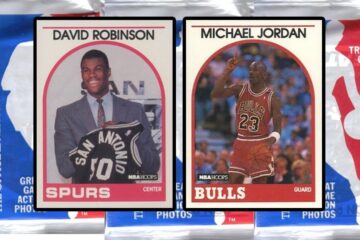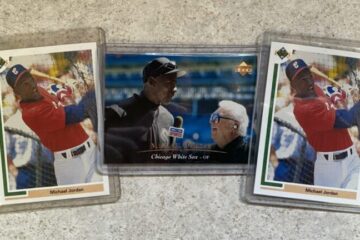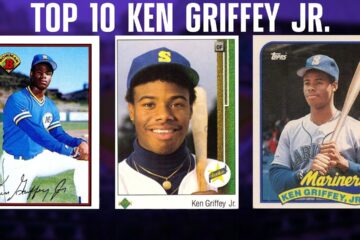The value of a trading card is based on its subject, grade, and authenticity. But the brand that publishes the trading card plays a role too, and Topps is way up there.
So we’re going to look at the most valuable 1973 Topps Baseball Cards. And as we dig in, we’ll learn more about the company itself, as well as the sporting superstars printed on each trading card. Let’s begin!
Most Valuable 1973 Topps Baseball Cards
1. 1973 TOPPS #380 Johnny Bench PSA 10 21769740

We’ll start at the top, pun intended. Today, the Topps Company makes collectibles, chewing gum, and candy. They’re the best-known trading card company in America and possibly the world, and they also sell cards under their sub-brands, Bowman and Allen & Ginter. But the company has its roots in Big Tobacco. The Saloman family got into the business in 1890.
- Card: Johhny Bench
- Team: Cincinnati Reds
- Value: $7,500
They called their company American Leaf Tobacco, and their business model was importing, reselling, and distributing tobacco leaves. WWI cut off their supply chain, so the company rebranded as Topps in 1938 to market chewing gum. As their name suggested, they planned to top their field, and even today, smokers often use gum to mask their bad tobacco breath.
2. 1973 Topps #594 Vic Harris Texas Rangers PSA 9 MINT

Today, chewing gum is ubiquitous. But back then, it was new and unfamiliar. Topps started with Bazooka Bubblegum, painting a small comic on the cover. By the 1950s, they decided to include trading cards in every pack of bubblegum. This enticed buyers, who were often more interested in the collectible than the gum itself. The first card featured Hopalong Cassidy.
- Card: Vic Harris
- Team: Texas Rangers
- Value: $850
Their first baseball card came out in 1951. Sy Berger was 28 when he designed it. He worked with cartoonist Woody Gelman to develop the card. Sy would bargain with ball players every year, asking them to be on his cards and paying them in carpets and fridges instead of cash. He made tons of cards, and in 1952, he dumped a bunch of unused ones into the Atlantic.
3. 1973 Topps #615 Rookie 3rd Basemen W/ Mike Schmidt RC HOF PSA 9 Mint
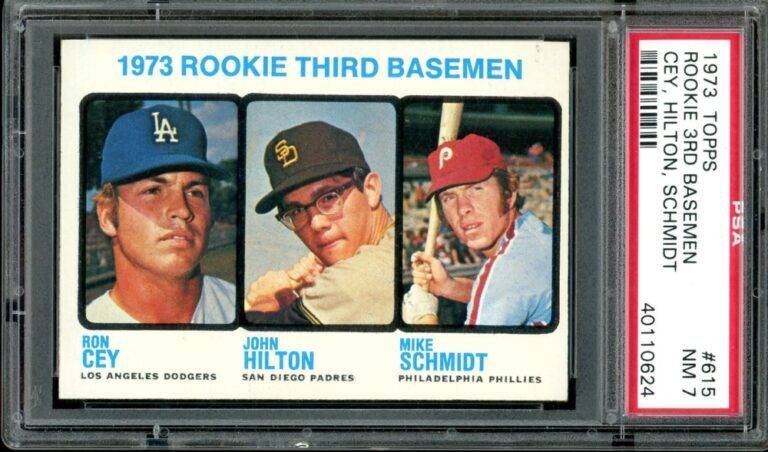
Hindsight is 2020, and when Sy was packing those leftover cards into a tugboat to drown them, he had no clue that his cards would one day be worth $15,000! That batch of ‘garbage’ included Mickey Mantle cards that are worth a fortune today. During the 2010s, Topps made an exclusive deal with MLB (Major League Baseball) for their official trading card products.
- Card: Cey, Hilton, Schmidt
- Team: Dodgers, Padres, Phillies
- Value: $234
But in 2022, Fanatics won the license, and to benefit from the reputation that Topps had already established, they took over the company. That deal netted $500 million for Topps owners and shareholders. But let’s go back to the beginning. The first Topps baseball cards were sold as a deck of 52 with either a red or blue back. The card front had a player’s portrait.
4. 1973 Topps Baseball #449 Ken Aspromonte / Indians Coaches PSA 9 Mint
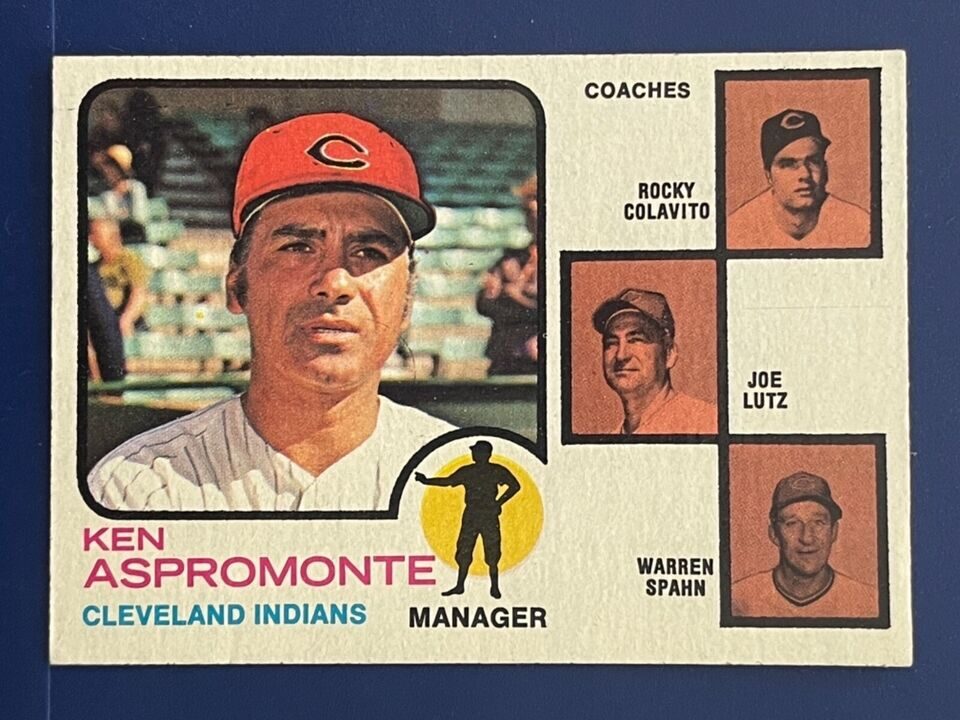
These initial cards had rounded corners and could be used as a regular pack of playing cards—the type used for poker or solitaire. By 1952, Topps included decks of 407 cards in its bubblegum packs. These cards had square corners and were slightly bigger, with a portrait on the front and the player’s stats on the back. The paintings were done by Gerry Dvorak.
- Card: Ken Aspromonte
- Team: Cleveland Indians
- Value: $62
Come 1957, the pictures were replaced with photos and the cards had a standard size of 2.5” by 3.5”. It’s worth mentioning that the chewing gum wasn’t very good and would damage the cards on occasion. But the brand scored major sales because collectors would toss the gum and keep the trading card. At the end of the year, any leftover cards were trashed or dumped.
5. 1973 Topps Baseball #305 Willie Mays PSA 9 Mint

Because Topps released baseball cards in series, their final set of the year would always come out after the season was over. Many of these cards ended up in the garbage, which means fewer copies were on the market. It’s these end-year series that comprise the most valuable Topps baseball cards today. And yes, that includes those famously priceless Mickey Mantles.
- Card: Willie Mays
- Team: New York Mets
- Value: $1,200
In 1950 and 1951, Topps and Bowman were both releasing baseball trading cards with their candy. Things got ugly, ended up in court, and resulted in conflicting contracts between players. Eventually, Topps bought Bowman out. Fleer stepped in next, selling retired player cards as a Baseball Greats series. And yes, Fleer was a gum company too. They didn’t get far.
6. 1973 Topps Baseball #247 Del Unser PSA 9 Mint

Topps maintained a monopoly on baseball cards until 1980, when a judge’s decision let Fleer and Donruss into the game. But even today, Topps cards rule the field. It’s why fans bought them out instead of trying to rival them. The Topps team has immense marketing savvy. Late in the year 2000, they partnered with eBay, still the top market for trading cards.
- Card: Del Unser
- Team: Cleveland Indians
- Value: $1,200
Topps would release physical baseball cards called etopps. Each card would have an IPO – an Initial Player Offering. For one week, you could only buy the card through eBay at its IPO price. To maintain the value of your card, Topps would store it for you in a climate-controlled vault. Then as the price went up, you could resell your card online without ever touching it!
7. 1973 Topps Complete Set Schmidt Ryan Mays Aaron, NM-NM/MT
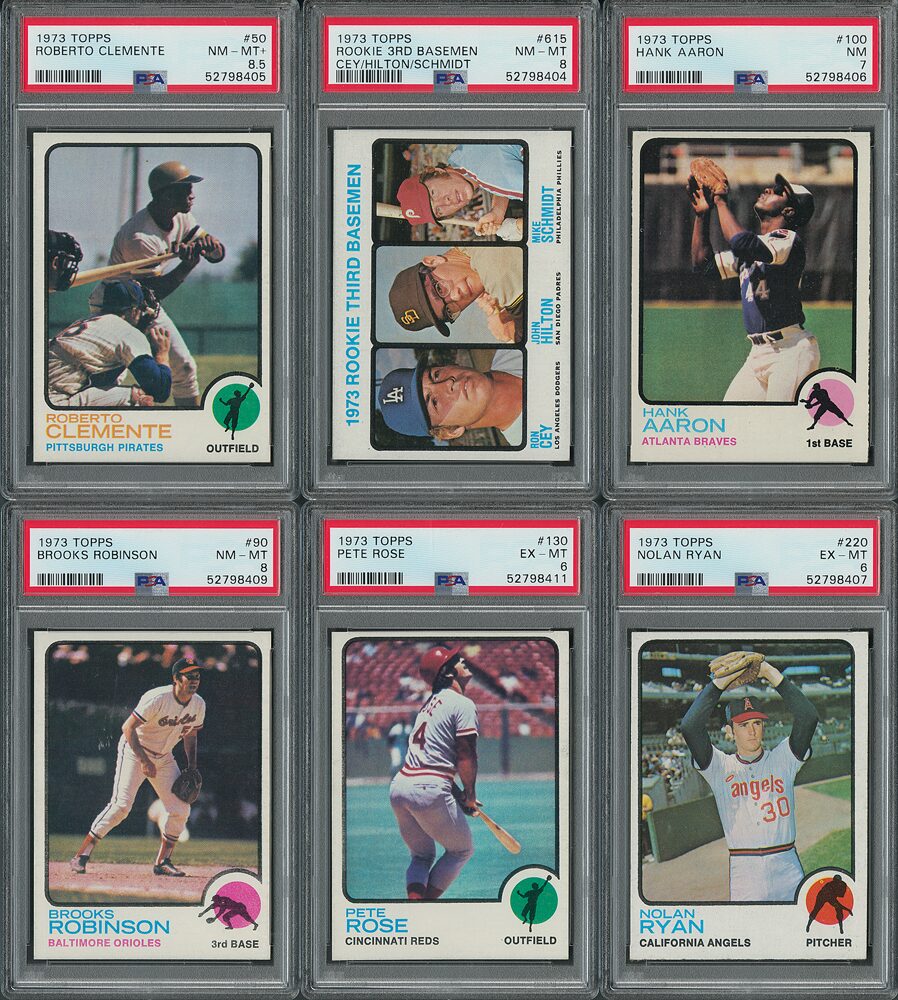
Of course, if you did want your etopps card, the company would happily deliver it to you. But just like showroom cars, the value drops the second it leaves the shop floor, so many buyers preferred to speculate and/or trade their etopps sight unseen. Also, while Topps officially started selling baseball card gum in the 1950s, the concept had been around since the 1930s.
- Card: Mixed (Set of 4 – Mays, Aaron, Cey, Hilton, Schmidt, Clement)
- Team: Mixed (Pirates, Braves, Mets, Dodgers, Padres, Phillies)
- Value: $3,051.01
The thing that differentiated Topps baseball cards was the printed player stats – it hadn’t been done before. They also introduced rookie cards and a few minor league cards that featured upcoming baseball stars. Collectors could use these stats to assign value to the cards. Kids played around with these stats to create imaginary baseball games. (Pokémon!!)
8. 1973 Topps #482 Rick Reuschel Chicago Cubs PSA 10 Gem Mint

At first, Topps baseball cards were sold as singles in packs of gum. But starting in 1974, Topps issued factory sets and still does so today. But as the trading card space expanded and new (bubblegum) companies popped in, Topps tried new tactics to maintain their market share. We mentioned one earlier: buying out their litigious competitor, Bowman Gum Co.
- Card: Rick Reuschel
- Team: Chicago Cubs
- Value: $2,000
Before the 1956 buyout, Bowman dominated the football trading card space, so Topps muscled in. And when Topps first took over, they subsumed the brand. Then, as rivals continued to appear, Topps revamped Bowman as a sub-brand in 1989. These later cards targeted upcoming pros, so they mainly featured rookies and minor league ball players.
9. 1973 Topps Baseball #245 Carl Yastrzemski PSA 9 Mint
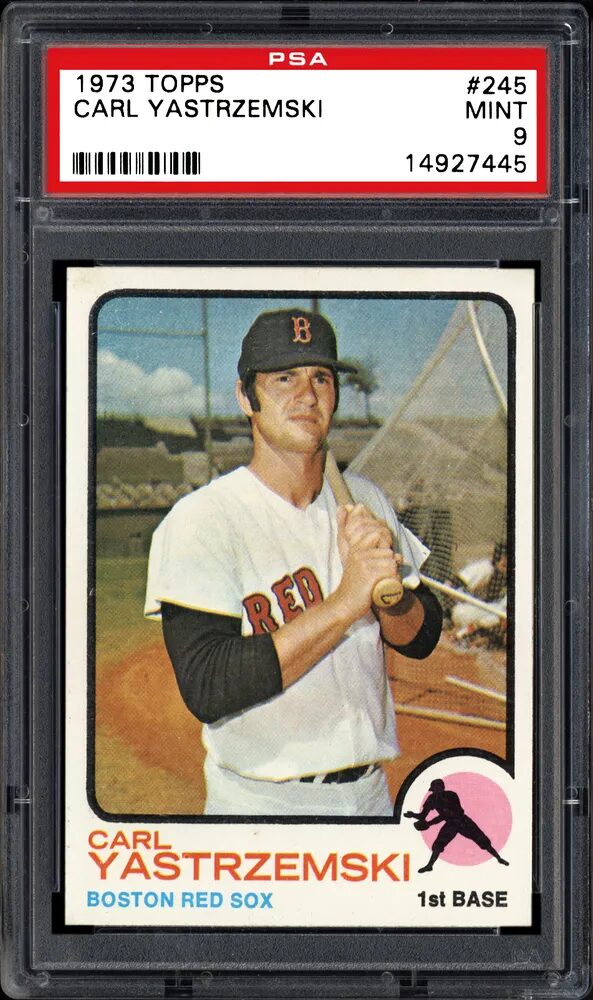
After 1974, Topps didn’t release another factory set of baseball cards until 1982. In the coming years, they will release fancy retail Christmas sets and plainer regular hobby sets. They also produced special themed sets with bonus cards. To maintain their monopoly, Topps got really good at segmenting their cards into niches that targeted certain consumer categories.
- Card: Carl Yastrzemski
- Team: Boston Red Sox
- Value: $1,275
Their Tiffany baseball card sets are the earliest example. Printed from 1984 to 1991, these cards had a white cardboard base and a glossy front. The photos and stats are the same as regular baseball cards, but the regular cards had grey cardboard bases and matte finishing. Tiffany sets are identified by the color of the box: red, blue, maroon, green, violet, or navy.
10. 1973 Topps Baseball #237 Eddie Matthews PSA 9 Mint (Burdette No. Right Ear)
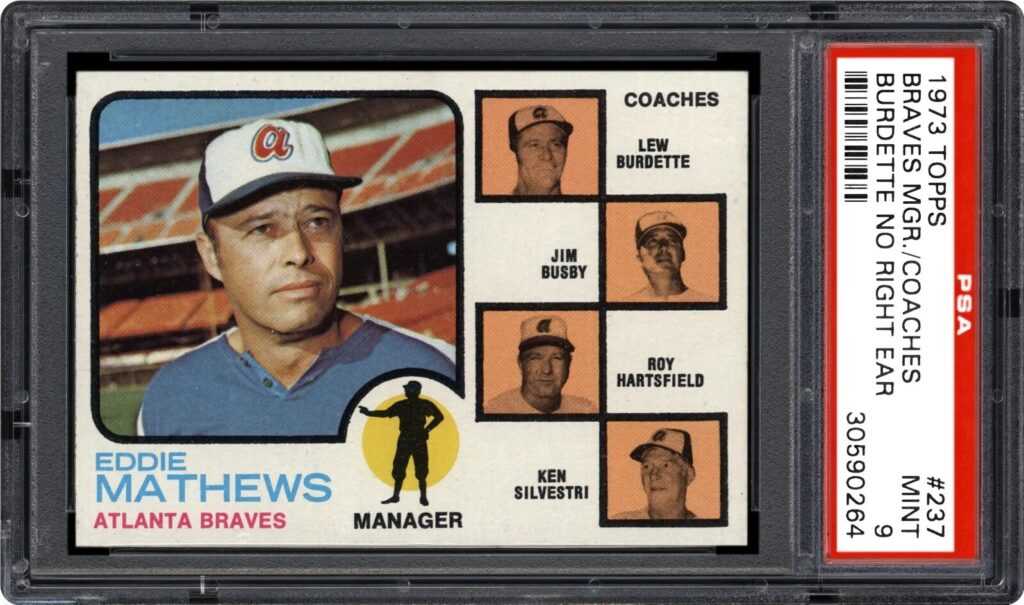
At first, Tiffany baseball cards were premium while Bowman cards were entry-level. But after 1992, Bowman cards got a pretty UV coating to retain their collectible value. That plus the chance to unveil upcoming stars made the Bowman baseball cards a fan favorite. After all, their value shoots up once that rookie or minor pro finally makes his name in the big leagues.
- Card: Eddie Matthews
- Team: Atlanta Braves
- Value: $1,775
Today, you can find Bowman cards in bronze, sterling, chrome, and platinum foil. Bowman also has special editions of draft picks and prospects that are popular among investors. These collectors might still love the game, but they mainly buy these cards for speculation. They know the card will appreciate in value as the player’s career keeps growing and progressing.
11. 1973 Topps Baseball #230 Joe Morgan PSA 9 Mint
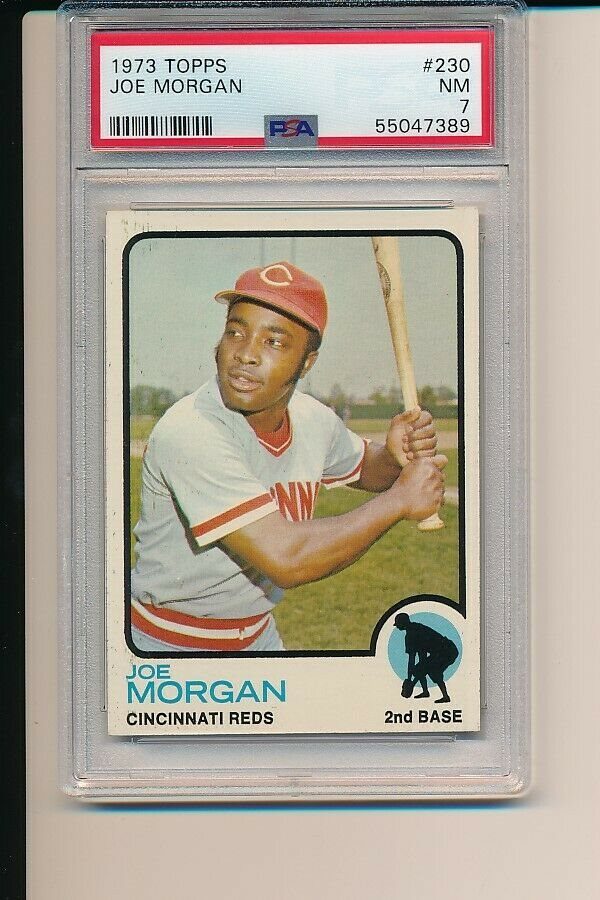
We’ve talked about the double-sided UV coating that upgraded Bowman cards. But they weren’t the first cards to test this feature. In 1991, Topps produced a set of Stadium Club cards as a premium offering. The cards had UV films, gold foil, and borderless photos. The cards featured seasoned players, so the back of the new card showed the player’s first card.
- Card: Joe Morgan
- Team: Cincinnati Reds
- Value: $2,650
In 1992, Topps followed up with a Stadium Club set made of plastic cards and packed in a dome that mimicked a baseball stadium. That year, they released two sets of Stadium Club cards – the regular cardboard set and the plastic stadium dome set. Then come 1993, Topps introduced Topps Finest. These super premium cards had an even higher price point at $25.
12. 1973 Topps Baseball #220 Nolan Ryan PSA 9 Mint
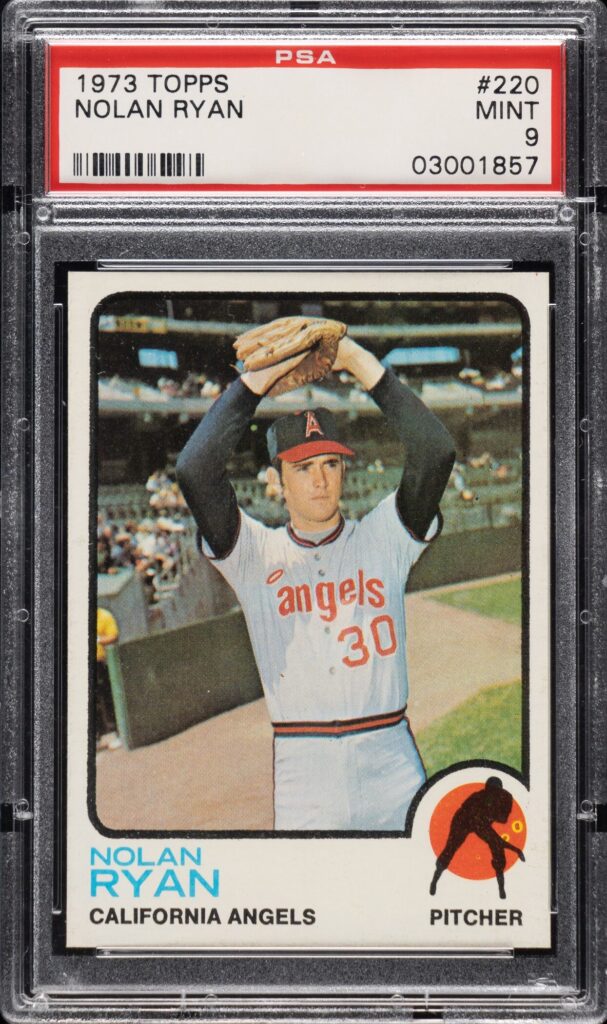
Topps Finest came in sets of 6 cards. The company made 4,000 cases, and each case carried a dozen boxes that had 18 packs each. Rare and expensive cards were randomly slipped into every box. These specialty cards included refractor cards and jumbo cards, and if you find one today, it could sell for $1,000. Refractors come in print runs of only 241 cards per player.
- Card: Nolan Ryan
- Team: California Angels
- Value: $900
A refractor card has the same pose, stats, and design as regular baseball cards, but they have a rainbow foiled front. These rare cards – and the possibility of finding one – inspired buyers to get a whole case and sift for treasure. But hobby collectors were often priced out of this space since speculators bought up all the boxes. You can make a bundle by investing in one.
13. 1973 Topps Baseball #130 Pete Rose PSA 9 Mint
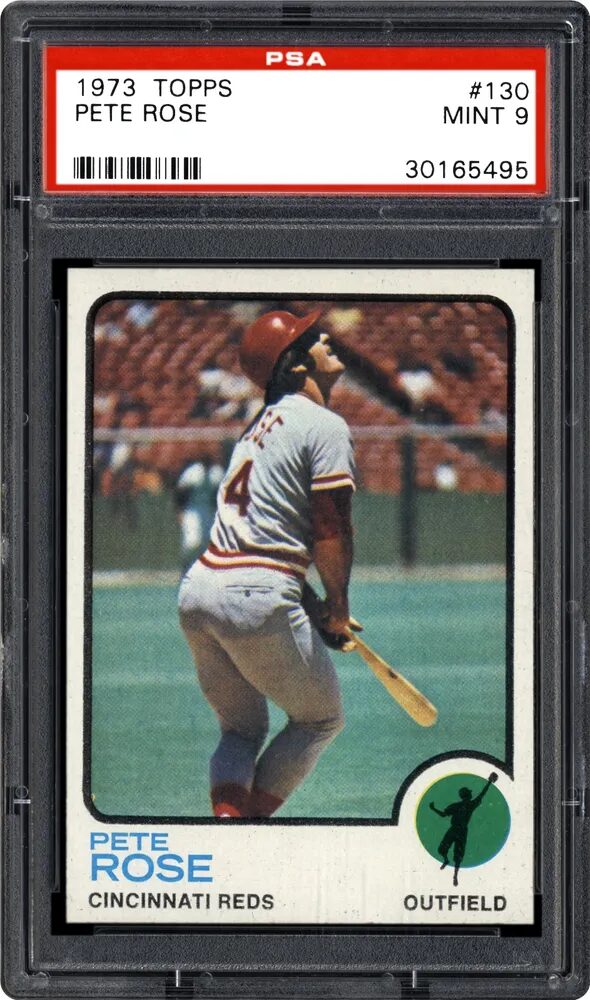
If you pay any attention at all to pop culture, you’ll notice its retro leanings, with revamps and remakes in fashion and film. Music too. And Topps played along. Starting 2001, they released 50th Anniversary editions that had contemporary players posed in previous styles. These throwback cards were positioned as Topps Heritage and Bowman Heritage collections.
- Card: Pete Rose
- Team: Cincinnati Reds
- Value: $1,225
For example, Topps cards from 2001 echoed the style of Bowman cards from 1948. The 2004 cards reflected Bowmans from 1955, while the 2001 set was oriented with 1949 settings. By 2007, Bowman Heritage was replaced by Allen & Ginter cards, also produced by Topps. But in 2019, the 1953 Bowman design was re-introduced as an exclusive online trading card.
14. 1973 Topps Baseball #50 Roberto Clemente PSA 9 Mint

Allen & Ginter cards used illustrated versions of baseball players – as opposed to the oil-painted or photographed ones, so they have vintage appeal. Following on this idea, Topps released their T206 in 2002, 2010, and 2020. These Topps 206 cards were first issued by America Leaf Tobacco from 1909 to 1911, so they offer that superior feeling of antiquity.
- Card: Roberto Clemente
- Team: Pittsburgh Pirates
- Value: $1,784.79
Also, between 1965 and 1992, Topps licensed the Canadian candy company O-Pee-Chee to produce clone cards for their market. These cards were identical to Topps releases but had the O-Pee-Chee logo at the bottom instead of Topps. These cards had to be bilingual after 1970 to comply with Canadian law. The second language translation was French-Canadian.
15. 1973 Topps Baseball #100 Hank Aaron PSA 9 Mint
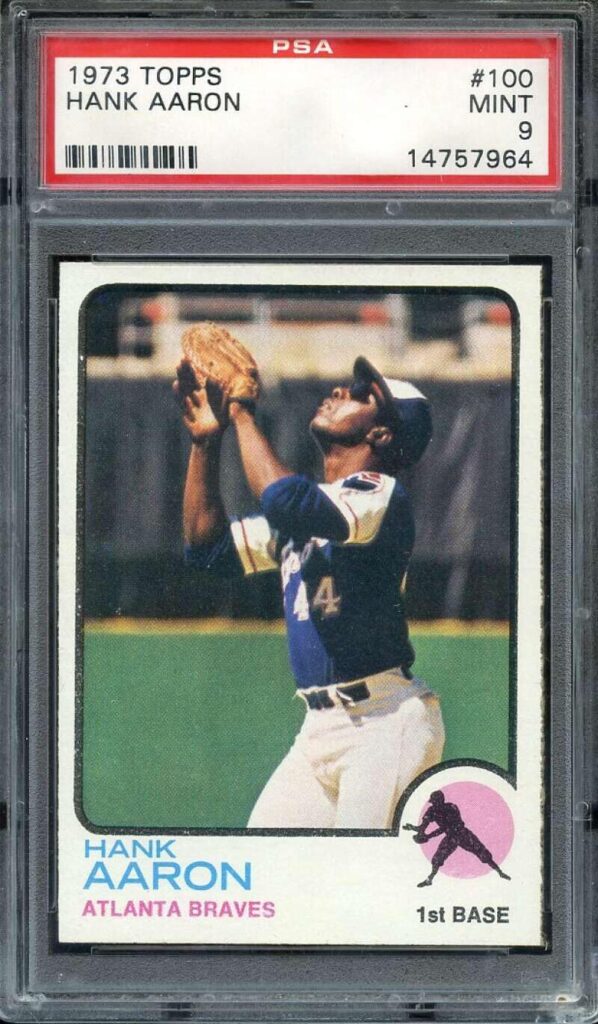
These localized Topps baseball trading cards seemed popular, so the company added versions for Venezuela and the UK. In the UK, kids play rounders, not baseball, so the cards had definitions of basic baseball terms and diamond-related jargon. Similarly, the Venezuela cards included players from the winter league. They were only published from 1959 to 1977.
- Card: Hank Aaron
- Team: Atlanta Braves
- Value: $1875
These foreign cards are a huge hit with collectors and speculators because they’re harder to find. But why is 1973 such a landmark year for Topps baseball cards? The 1972 set had 787 cards, but by 1973, they were culled to 660. They also took a more conservative approach. The cards had thin black borders and looked cleaner and less colorful than prior designs.
16. Hank Aaron Willie Mays HOF Signed 1973 Topps #1 DUAL AUTO BGS BAS Authentic

In 1972, Topps baseball cards had players framed in a bright border with their team name prominent at the top, and the player’s name in smaller font at the bottom. 1973 cards focused on the ball player. The photo dominated the card, with their name in colored letters and the team name in smaller font at the bottom, and the player’s position silhouetted in one corner.
- Card: All-Time Home Runs (Ruth, Aaron, Mays)
- Team: Mixed
- Value: $1,666
Some collectors disliked the toned-down style of 1973 cards, so the colors came back in later years. There was also an issue of players changing teams, and Topps handled that in different ways. Sometimes, the player would pose without his baseball cap, allowing Topps to easily change their uniform. Minor league uniforms could be airbrushed into MLB ones as needed.
17. 1973 Topps #497 Cardinals Manager Coaches Dark Pale Background PSA 9 MINT

As we wind up, let’s talk about how Topps numbers their most valuable baseball cards. We’ve talked about that Mickey Mantle card several times in this article, and many collectors consider it the most valuable Topps baseball card ever. Players of that caliber have 00 or 50 as the last digits in their trading cards. So Mickey Mantle is #50 and Willie Mays is #250.
- Card: Red Schoendienst
- Team: St. Louis Cardinals
- Value: $810
Similarly, Sandy Koufax is #100. If further cards are released, you might see a #5750 Mickey or a #89100 Sandy. Minor league stars and rookies had numbers ending in #5, and they would appear on entry-level cards before joining any official card set. These are good cards for speculative investment. The rest of the players have standard numbers, so anything goes.
Do you own any valuable 1973 Topps baseball cards? Share photos in the comments please!
